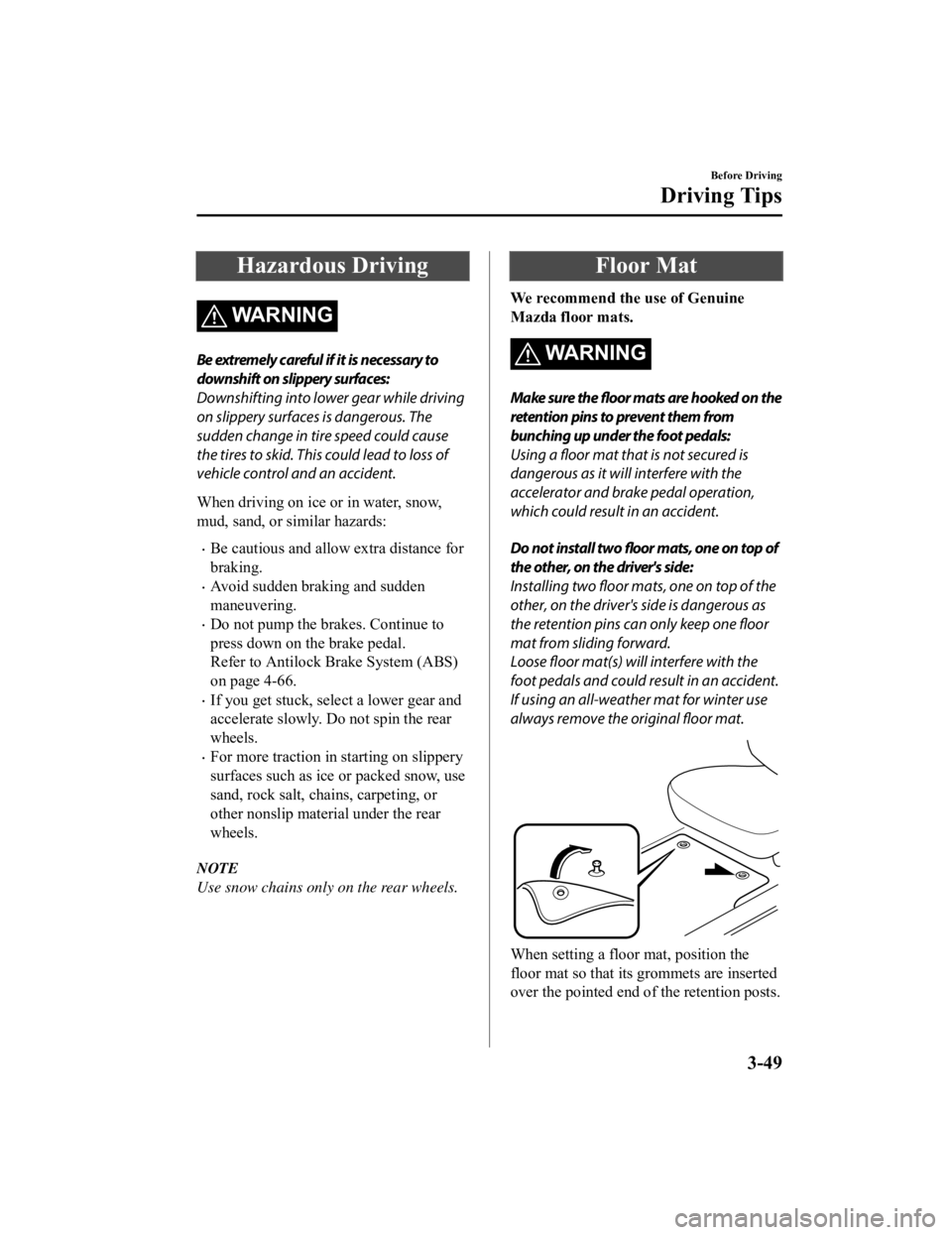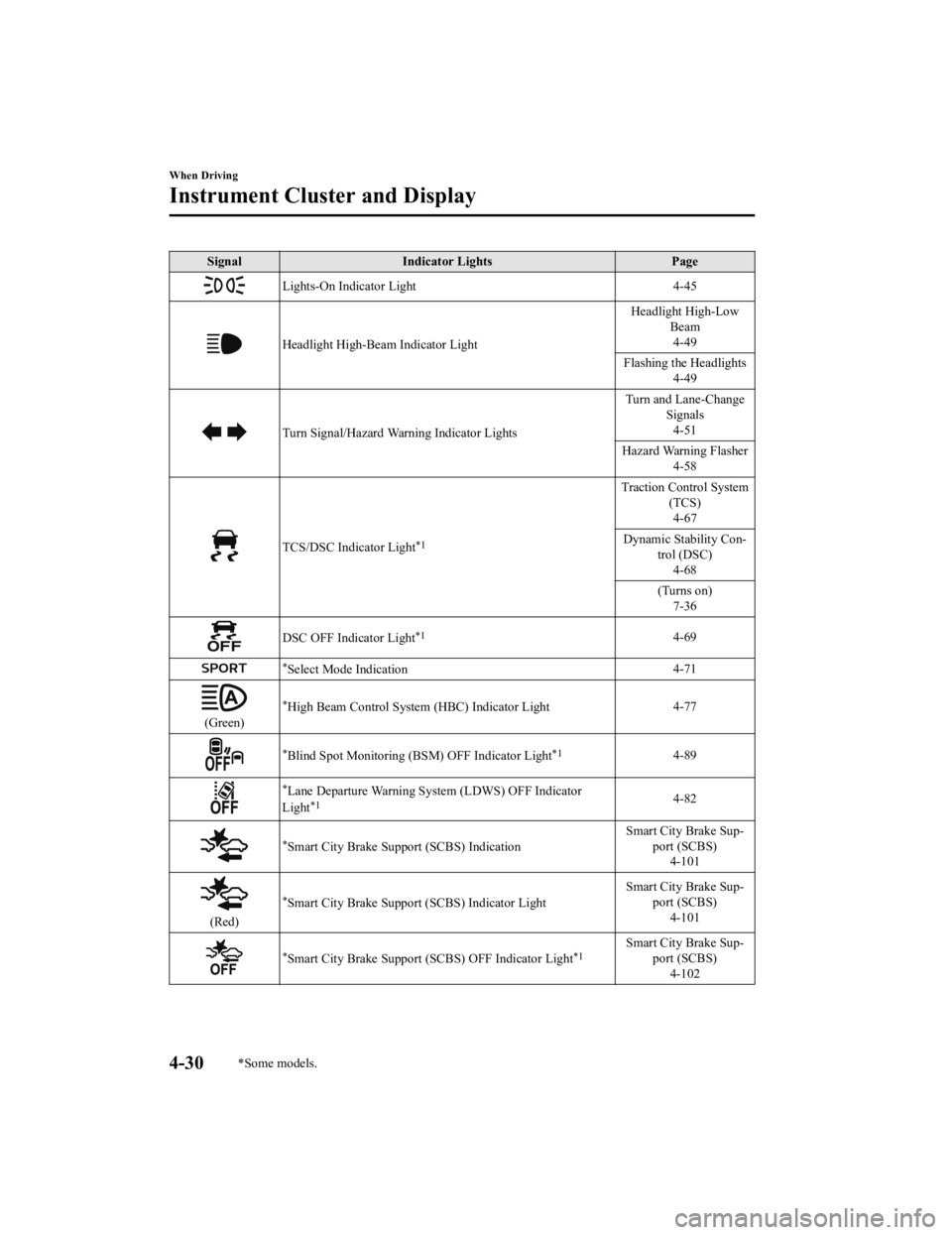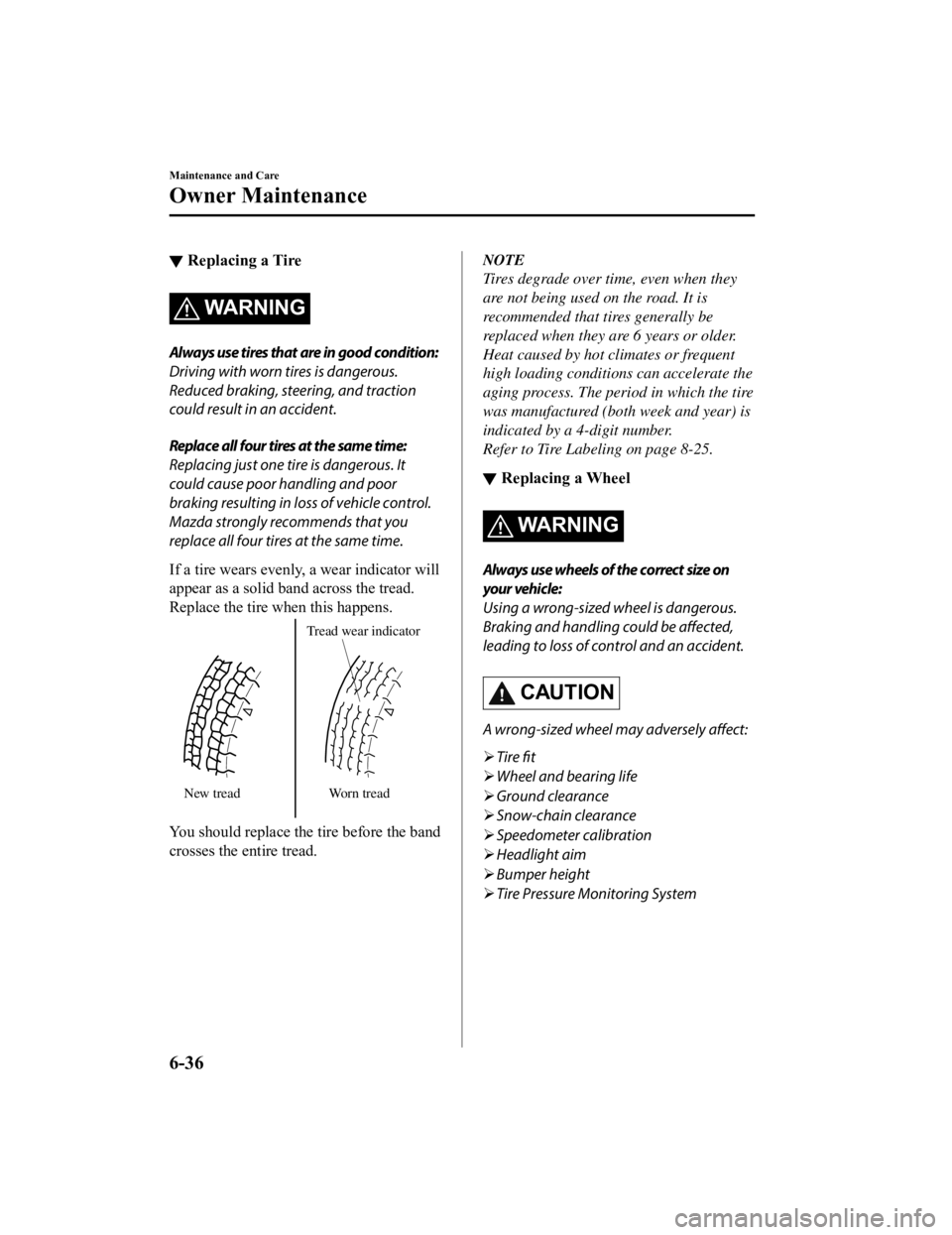traction control MAZDA MODEL MX-5 MIATA RF 2021 Owners Manual
[x] Cancel search | Manufacturer: MAZDA, Model Year: 2021, Model line: MODEL MX-5 MIATA RF, Model: MAZDA MODEL MX-5 MIATA RF 2021Pages: 499, PDF Size: 6.83 MB
Page 120 of 499

Hazardous Driving
WARNING
Be extremely careful if it is necessary to
downshift on slippery surfaces:
Downshifting into lower gear while driving
on slippery surfaces is dangerous. The
sudden change in tire speed could cause
the tires to skid. This could lead to loss of
vehicle control and an accident.
When driving on ice or in water, snow,
mud, sand, or similar hazards:
Be cautious and allow extra distance for
braking.
Avoid sudden braking and sudden
maneuvering.
Do not pump the brakes. Continue to
press down on the brake pedal.
Refer to Antilock Brake System (ABS)
on page 4-66.
If you get stuck, select a lower gear and
accelerate slowly. Do not spin the rear
wheels.
For more traction in starting on slippery
surfaces such as ice or packed snow, use
sand, rock salt, chains, carpeting, or
other nonslip material under the rear
wheels.
NOTE
Use snow chains only on the rear wheels.
Floor Mat
We recommend the use of Genuine
Mazda floor mats.
WA R N I N G
Make sure the floor mats are hooked on the
retention pins to prevent them from
bunching up under the foot pedals:
Using a floor mat that is not secured is
dangerous as it will interfere with the
accelerator and brake pedal operation,
which could result in an accident.
Do not install two floor mats, one on top of
the other, on the driver's side:
Installing two floor mats, one on top of the
other, on the driver's side is dangerous as
the retention pins can only keep one floor
mat from sliding forward.
Loose floor mat(s) will interfere with the
foot pedals and could result in an accident.
If using an all-weather mat for winter use
always remove the original floor mat.
When setting a floor mat, position the
floor mat so that its grommets are inserted
over the pointed end of the retention posts.
Before Driving
Driving Tips
3-49
MX-5_8JS9-EA-20K_Edition1_old 2020-8-28 13:50:01
Page 128 of 499

4When Driving
Information concerning safe driving and stopping.
Start/Stop Engine.............................. 4-4 Ignition Switch........ ..................... 4-4
Starting the Engine....................... 4-5
Turning the Engine Off............... 4-11
Instrument Cluster and Display ............
........................................................... 4-12 Meters and Gauges..................... 4-12
Multi-information Display and INFO
Switch
*....................................... 4-19
Warning/Indicator Lights............4-27
Manual Transmission
Operation......................................... 4-32 Manual Transmission Shift
Pattern......................................... 4-32
Automatic Transmission................. 4-35 Automatic Transmission
Controls...................................... 4-35
Shift-Lock System...................... 4-36
Transmission Ranges.................. 4-36
Manual Shift Mode..................... 4-38
Direct Mode
*.............................. 4-43
Driving Tips................................4-44
Switches and Controls..................... 4-45 Lighting Control......................... 4-45
Turn and Lane-Change
Signals........................................ 4-51
Windshield Wipers and
Washer........................................ 4-52
Rear Window Defogg er.............. 4-56
Horn............................................ 4-57
Hazard Warning Flasher............. 4-58
HomeLink Wireless Control
System
*.......................................4-58
Brake................................................ 4-62 Brake System.............................. 4-62
Hill Launch Assist (HLA)
*.........4-65
ABS/TCS/DSC................................. 4-66 Antilock Brake System
(ABS)..........................................4-66
Traction Control System
(TCS).......................................... 4-67
Dynamic Stability Control
(DSC)..........................................4-68
Drive Selection................................. 4-70 Drive Selection
*..........................4-70
Power Steering................................. 4-72 Power Steering............................4-72
i-ACTIVSENSE............................... 4-73 i-ACTIVSENSE
*........................4-73
Adaptive Front Lighting System
(AFS)
*........................................ 4-75
High Beam Control System
(HBC)
*........................................4-76
Lane Departure Warning System
(LDWS)
*.................................... 4-79
Blind Spot Monitoring (BSM)
*.........
.................................................... 4-85
*Some models.4-1
MX-5_8JS9-EA-20K_Edition1_old 2020-8-28 13:50:01
Page 157 of 499

SignalIndicator Lights Page
Lights-On Indicator Light 4-45
Headlight High-Beam Indicator LightHeadlight High-Low
Beam4-49
Flashing the Headlights 4-49
Turn Signal/Hazard Warning Indicator Lights Turn and Lane-Change
Signals4-51
Hazard Warning Flasher 4-58
TCS/DSC Indicator Light*1
Traction Control System(TCS)4-67
Dynamic Stability Con‐ trol (DSC)4-68
(Turns on) 7-36
DSC OFF Indicator Light*14-69
*Select Mode Indication 4-71
(Green)
*High Beam Control System (HBC) Indicator Light4-77
*Blind Spot Monitoring (BSM) OFF Indicator Light*14-89
*Lane Departure Warning System (LDWS) OFF Indicator
Light*14-82
*Smart City Brake Support (SCBS) Indication Smart City Brake Sup‐
port (SCBS)4-101
(Red)
*Smart City Brake Support (SCBS) Indicator Light Smart City Brake Sup‐
port (SCBS)
4-101
*Smart City Brake Support (SCBS) OFF Indicator Light*1Smart City Brake Sup‐
port (SCBS)4-102
When Driving
Instrument Cluster and Display
4-30*Some models.
MX-5_8JS9-EA-20K_Edition1_old 2020-8-28 13:50:01
Page 194 of 499

Traction Control System(TCS)
The Traction Control System (TCS)
enhances traction and safety by controlling
engine torque and braking. When the TCS
detects driving wheel slippage, it lowers
engine torque and operates the brakes to
prevent loss of traction.
This means that on a slick surface, the
engine adjusts automatically to provide
optimum power to the drive wheels,
limiting wheel spin and loss of traction.
The warning light turns on when the
system has a malfunction.
Refer to Contact Authorized Mazda
Dealer and Have Vehicle Inspected on
page 7-36.
WARNING
Do not rely on the Traction Control System
(TCS) as a substitute for safe driving:
The Traction Control System (TCS) cannot
compensate for unsafe and reckless
driving, excessive speed, tailgating
(following another vehicle too closely), and
hydroplaning (reduced tire friction and
road contact because of water on the road
surface). You can still have an accident.
Use snow tires or tire chains and drive at
reduced speeds when roads are covered
with ice and/or snow:
Driving without proper traction devices on
snow and/or ice-covered roads is
dangerous. The Traction Control System
(TCS) alone cannot provide adequate
traction and you co uld still have an
accident.
NOTE
To turn off the TCS, press the DSC OFF
switch (page 4-69).
▼ TCS/DSC Indicator Light
This indicator light stays on for a few
seconds when the ignition is switched ON.
If the TCS or DSC
is operating, the
indicator light flashes.
If the light stays on, the TCS, DSC or the
brake assist system may have a
malfunction and they may not operate
correctly. Take your vehicle to an
Authorized Mazda Dealer.
NOTE
In addition to the indicator light
flashing, a slight lugging sound will
come from the engine. This indicates
that the TCS/DSC is operating properly.
On slippery surfaces, such as fresh
snow, it will be impossible to achieve
high rpm when the TCS is on.
When Driving
ABS/TCS/DSC
4-67
MX-5_8JS9-EA-20K_Edition1_old 2020-8-28 13:50:01
Page 333 of 499

▼Replacing a Tire
WA R N I N G
Always use tires that are in good condition:
Driving with worn tires is dangerous.
Reduced braking, steering, and traction
could result in an accident.
Replace all four tires at the same time:
Replacing just one ti
re is dangerous. It
could cause poor handling and poor
braking resulting in loss of vehicle control.
Mazda strongly recommends that you
replace all four tires at the same time.
If a tire wears evenly, a wear indicator will
appear as a solid band across the tread.
Replace the tire when this happens.
New tread Tread wear indicator
Worn tread
You should replace the tire before the band
crosses the entire tread.
NOTE
Tires degrade over time, even when they
are not being used on the road. It is
recommended that tires generally be
replaced when they are 6 years or older.
Heat caused by hot climates or frequent
high loading conditions can accelerate the
aging process. The period in which the tire
was manufactured (both week and year) is
indicated by a 4-digit number.
Refer to Tire Labeling on page 8-25.
▼Replacing a Wheel
WA R N I N G
Always use wheels of the correct size on
your vehicle:
Using a wrong-sized wheel is dangerous.
Braking and handling could be
affected,
leading to loss of control and an accident.
CAUTION
A wrong-sized wheel may adversely affect:
Tire fit
Wheel and bearing life
Ground clearance
Snow-chain clearance
Speedometer calibration
Headlight aim
Bumper height
Tire Pressure Monitoring System
Maintenance and Care
Owner Maintenance
6-36
MX-5_8JS9-EA-20K_Edition1_old 2020-8-28 13:50:01
Page 454 of 499

Uniform Tire Quality Grading System (UTQGS)
This information relates to the tire grading system developed by the U.S. National Highway
Traffic Safety Administration for grading tires by tread wear, traction, and temperature
performance.
▼ Tr e a d We a r
The tread wear grade is a comparative rating based on the wear
rate of the tire when tested
under controlled conditions on a specified government test cour se.
For example, a tire graded 150 would wear one-and-a-half times as well on the government
course as a tire graded 100.
The relative performance of tires depends upon the actual condi tions of their use, however,
and may depart significantly from the norm because of variation s in driving habits, service
practices and differences in ro ad characteristics and climate.
▼Traction-AA, A, B, C
The traction grades, from highest
to lowest, are AA, A, B, and C. These grades represent the
tire's ability to stop on wet pavement as measured under contro lled conditions on specified
government test surfaces of asphalt and concrete. A tire marked C may have poor traction
performance.
WARNING
The traction grade assigned to this tire is based on braking (straight ahead) traction tests and
does not include acceleration cornering (turning), hydroplaning, or peak traction
characteristics.
▼ Temperature-A, B, C
The temperature grades A (the hi
ghest), B, and C, represent the tire's resistance to the
generation of heat and its ability to dissipate heat when teste d under controlled conditions
on a specified indoor laboratory test wheel.
Sustained high temperature can cause the material of the tire to degenerate and reduce tire
life, and excessive temperatures can lead to sudden tire failure.
Grade C corresponds to a level of performance which all passeng er vehicle tires must meet
under the Federal Motor Vehicle Safety Standard No. 109. Grades B and A represent higher
levels of performance on the labo ratory test wheel than the minimum required by law.
Customer Information and Reporting Safety Defects
Uniform Tire Quality G rading System (UTQGS)
8-23
MX-5_8JS9-EA-20K_Edition1_old 2020-8-28 13:50:01
Page 458 of 499

Letter RatingSpeed Rating
V 149 mph
W 168
* mph
Y 186
* mph
* For tires with a maximum speed capability over 149 mph, tire manufacturers sometimes use the letters ZR. For
tires with a maximum speed cap ability over 186 mph, tire manufa cturers always use the letters ZR.
MS or M/S: Mud and Snow
AT: All Terrain.
AS: All Season. The “M
S” or “M/S” indicates that the tire has some functional use in mud
and snow.
U.S. DOT Tire Identifi cation Number (TIN)
This begins with the letters “DOT” which indicates the tire mee ts all federal standards. The
next two numbers or letters are the plant code where it was man ufactured, and the last four
numbers represent the week and year the tire was manufactured. For example, the numbers
457 means the 45st week of 1997. After 2000 the numbers go to f our digits. For example,
the number 2102 means the 21th week of 2002. The other numbers are marketing codes
used at the manufacturer's discretion. This information is used to contact consumers if a tire
defect requires a recall.
Tire Ply Composition and Materials Used
The number of plies indicates the number of layers of rubber-co ated fabric in the tire. In
general, the greater the number of plies, the more weight a tir e can support. Tire
manufacturers also must indicate the tire materials, which incl ude steel, nylon, polyester,
and other.
Maximum Load Rating
This number indicates the maximum load in kilograms and pounds that can be carried by the
tire.
Maximum Permissible Inflation Pressure
This number is the greatest amoun t of air pressure that should ever be put in the tire under
normal driving conditions.
Tread Wear, Traction and Temperature Grades
Tr e a d w e a r : The tread wear grade is a comparative rating based on the wear rate of the tire
when tested under controlled con ditions on a specified government test course. For
example, a tire graded 150 would wear one and one-half (1 1/2) times as well on the
government course as a tire graded 100.
Customer Information and Reporting Safety Defects
Tire Information (U.S.A.)
8-27
MX-5_8JS9-EA-20K_Edition1_old 2020-8-28 13:50:01
Page 459 of 499

Traction: The traction grades, from highe st to lowest are AA, A, B, and C. The grades
represent the tire's ability to stop on wet pavement as measure d under controlled conditions
on specified government test surfaces of asphalt and concrete. A tire marked C may have
poor traction performance.
Te m p e r a t u r e : The temperature grades are A (the highest), B and C, represent ing the tire's
resistance to the generation of heat and its ability to dissipa te heat when tested under
controlled conditions on a spec ified indoor laboratory test whe el.
Snow Tires
In some heavy snow areas, local governments may require true sn ow tires, those with very
deeply cut tread. These tires should only be used in pairs or p laced on all four wheels. Make
sure you purchase snow tires that are the same size and construction type as the other tires
on your vehicle.
SAFETY WARNING
The following safety warning a ppears on the tire's sidewall.
SERIOUS INJURY MAY RESULT FROM:
EXPLOSION OF TIRE/RIM ASSEMBLY DUE TO IMPROPER MOUNTING-MATCH
TIRE DIAMETER TO RIM D IAMETER; NEVER EXCEED 40 psi (275 kPa) TO SEAT
BEADS-ONLY SPECIALLY TRAINED PERSONS SHOULD MOUNT TIRES.
TIRE FAILURE DUE TO UNDER-INFLATION/OVERLOADING/
DAMAGE-FOLLOW OWNER'S MANUAL AND PLACARD IN
VEHICLE-FREQUENTLY CHECK INFLATION PRESSURE AND INSPECT FOR
DAMAGE.
▼ Information on Temporary Tires
Please refer to the sample below.
Customer Information and Reporting Safety Defects
Tire Information (U.S.A.)
8-28
MX-5_8JS9-EA-20K_Edition1_old
2020-8-28 13:50:01
Page 498 of 499

Index
Collision warning...................... 4-101
Smart City Brake Support (SCBS)
Indicator Light (Red).................4-101
Stopping the Smart City Brake
Support (SCBS) System
Operation................................... 4-102
Specifications...................................... 9-4
Speedometer...................................... 4-13
SRS Air Bags How the SRS air bags work........ 2-43
Limitations to SRS air bag.......... 2-47
Monitoring................................... 2-55
Passenger occupant classification
system.......................................... 2-49
SRS air bag deployment
criteria.......................................... 2-46
Supplemental restraint system
components.................................. 2-42
Starting the Engine..............................4-5
Steering Wheel
Horn............................................. 4-57
Storage Compartments ...................... 5-42
Back trim storage box................. 5-43
Console box................................. 5-42
Seat side box............................... 5-42
Sunvisors........................................... 5-35
T
Tachometer........................................ 4-14
Theft-Deterrent System ..................... 3-46
Tiedown Hook............................................ 7-31
Tires................................................... 6-34 Flat tire.......................................... 7-3
Replacing a tire........................... 6-36
Replacing a wheel....................... 6-36
Snow tires.................................... 3-51
Specifications.................................9-9
Tire chains................................... 3-51
Tire inflation pressure................. 6-34
Tire rotation................................. 6-35
Uniform tire quality grading system
(UTQGS)..................................... 8-23
Tire Inflation Pressure Warning
Beep...................................................7-50
Tire Information................................ 8-25
Tire Pressure Monitoring System.... 4-114
To w i n g
Recreational towing.....................3-55
Trailer towing.............................. 3-55
Towing Description........................... 7-30
Traction Control System (TCS)........ 4-67 TCS/DSC indicator light............. 4-67
Traffic Sign Recognition System
(TSR)................................................. 4-90
Transmitter.......................................... 3-5
Trip Computer................................... 4-17
Trip Meter......................................... 4-13
Trouble Battery runs out........................... 7-23
Emergency starting...................... 7-26
Emergency towing....................... 7-30
Flat tire.......................................... 7-3
Overheating................................. 7-27
Parking in an emergency............... 7-2
When fuel-filler lid cannot be
opened..........................................7-29
When the roof cannot be
closed........................................... 7-57
When trunk lid cannot be
opened..........................................7-52
Trunk Lid............ .............................. 3-19
Inside trunk release lever............ 3-21
When trunk lid cannot be
opened..........................................7-52
Turn Signals...................................... 4-51
V
Vanity Mirrors................................... 5-35
Vehicle Information Labels................. 9-2
10-7
MX-5_8JS9-EA-20K_Edition1_old 2020-8-28 13:50:01